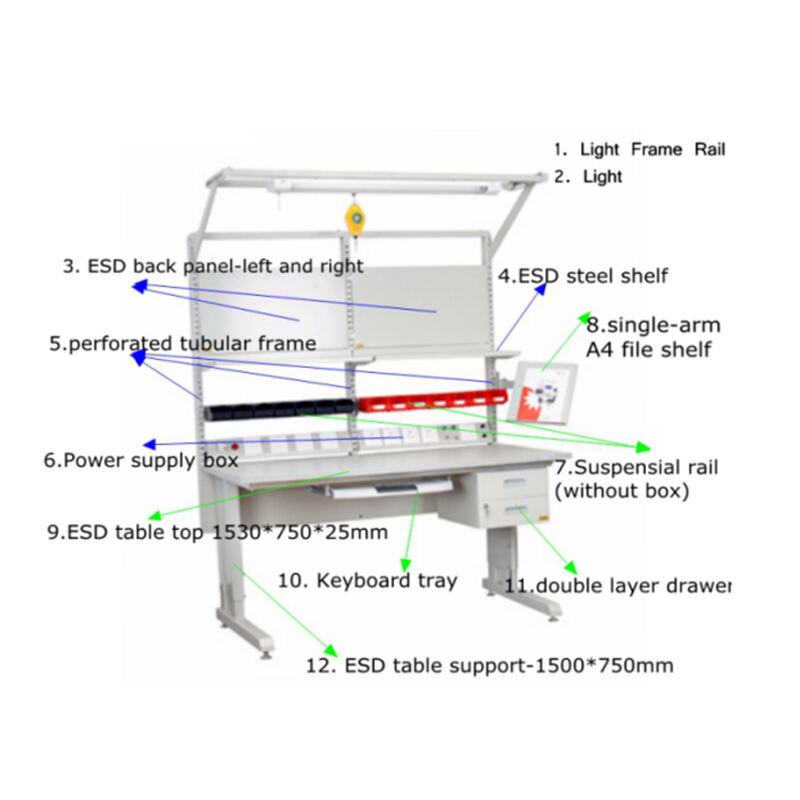The assembly of Printed Circuit Boards requires significant attention beyond just obtaining appropriate tools for a productive workspace. Establishing an environment design to reduce Electrostatic Discharges (ESD) stands crucial since ESD damages sensitive electronic components. The guide delivers comprehensive guideline instruction about constructing ESD workbenches for PCB assembly to maximize operational safety and efficiency.
Layout Optimization and Component Handling
Designing the Ideal Layout
An efficient ESD workbench depends heavily on designing a well-designed layout. Your first layout optimization task requires you to discover all stages involved in your PCB assembly workflow. Stage mapping should start from the first step in component preparation running through to the final testing phase. Put these work stages into either linear or circular arrangements to avoid unnecessary worker movement and to decrease ESD occurrence.
Place all essential workplace equipment in positions that are easily accessible for workers. Clients should employ essential ESD-safe components such as ESD-safe mats in conjunction with grounding monitors as well as wrist straps and soldering irons. The placement of production tools near your operational reach will prevent unintended tool damage while boosting production speed.
Efficient Component Handling
Cautious handling of electronic elements needs both concentration and precise action. Placing components inside ESD-safe packaging such as anti-static bins and bags plays an important role for successful protection from electrostatic discharge. Leads from electronic components must be handled using ESD-safe tweezers along with vacuum pick-up tools instead of manual contact.
Mount all assembly parts onto a conducting surface which should be an ESD mat. Static charges need to dissipate on a grounded base because doing so prevents harm to sensitive components. A complete labeling system will help both maintain component organization and minimize human handling mistakes in the field.
Static-Safe Soldering Techniques
Grounding Systems
A reliable grounding system functions as the most critical element to maintain a static-free workspace. The soldering station needs grounding alongside an obligatory requirement for wearing a grounding strap throughout soldering operations. The workbench must contain an ESD mat which connects securely to earth ground to achieve proper static discharge.
Real-time tracking of ESD protection assets takes place through the critical utility of grounding monitors. Grounding monitors notify users if any of their static dissipative equipment disconnects from the grounding system or when ESD mats lose ground connection.
ESD-Safe Soldering Equipment
Participation in soldering operations requires ESD-safe equipment that provides serious protection. Since traditional soldering irons create substantial static, you need ESD-safe alternatives in operation. Select soldering irons designed with grounding features which combine with insulation systems to stop static accumulation.
A soldering station equipped with an ionizer system should be used for all soldering work because it provides ESD protection. The devices erase electric charges which build up on both your workbench and tools to protect your PCB assembly.
Best Practices for Soldering
The practice of soldering PCB surfaces requires careful attention to essential procedures which help components stay undamaged.
Preheat Components: Preheating of components before soldering reduces their exposure to temperature shock that would otherwise result in damage.
Use the Right Solder: It is essential to use solder which is designed for electronics applications while being ESD-safe.
Temperature Control: You should keep your soldering tip temperature stable because overheating components creates problems. The most suitable temperature span for soldering applications falls between 260°C to 370°C (500°F to 700°F).
Cleanliness: Your soldering iron functions better when its tip remains clean which leads to exact soldering performance and avoids substance pollutants.
Ongoing Maintenance and Safety Check
Regular Inspections
Your ESD workbench setup needs ongoing inspections to guarantee its long-term operational efficiency. You need to examine the status of all grounding connectors together with ESD mats and wrist straps for any signs of damage or wear. An ESD-safe environment requires immediate replacement of worn-out components.
Training and Protocols
Every individual who works in the area needs to receive regular training about ESD procedures. All personnel within the workstation must grasp the relevance of ESD safety procedures and uphold the already defined protocols. Guidelines about both new component receipt and handling methods should be established to protect against accidental ESD damage.
Conclusion
The establishment of an ESD workbench for PCB assembly demands specialized preparations together with faithful adherence to industry best practices. Protection of sensitive electronics depends on all critical steps from component handling to static-safe soldering methods in addition to optimized workbench design. Regular maintenance and ongoing training ensure that your ESD-safe environment remains effective over time. Following this broad guide will help you to create a field that not only increases productivity, but also preserves the integrity of your PCB assembly.







